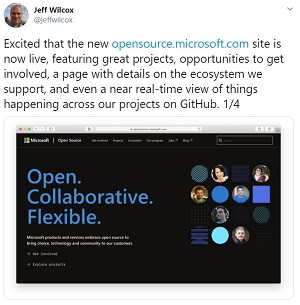News
Formerly a Proprietary 'Evil Empire,' Microsoft Shows Off Embrace of Open Source
It's well known how Microsoft has transformed from a proprietary, monolithic software "Evil Empire" to an inclusive open source champion, but just in case you didn't get the message yet, a new company site will do the trick.
The new open source site is headlined by three words: open, collaborative and flexible.
In addition to showing off all the open source components its own developers use, the site highlights the company's own myriad open source projects ranging from Blazor to Visual Studio Code.
It also puts the spotlight on other open source initiatives such as joining the Open Source Security Foundation earlier this month to add to its open source memberships, which includes the company joining the Open Source Initiative in 2017.
 [Click on image for larger view.] Microsoft Open Source Twitter Announcement (source: Twitter).
[Click on image for larger view.] Microsoft Open Source Twitter Announcement (source: Twitter).
The site also lists the tools and services its developers use in supporting the company's open source program, describing the following collections that other organizations might find useful:
- GitHub Enterprise Cloud with SAML single-sign on
- GitHub Actions and Azure Pipelines
- Component Governance
- GitHub Bots
- Self-service GitHub open source portal
- ClearlyDefined
- CLA Assistant
- GitHub data crawling
- Business review process with Azure Boards
Some of those components are instrumental to the company's One Engineering System (1ES) that makes using, releasing and contributing to open source an easy, efficient, native part of the engineering experience.
"Building on a foundation of eliminate (reducing complex and dated policies for the modern engineering era), automate (detecting open source use, automated policy and decision guides, legal alerts and security workflows), and delegate (letting business groups make decisions aligned with their priorities and goals), the open source program has scaled," the site says, listing the below:
- Built into the engineering system: Powered by GitHub and Azure Pipelines, and internal hyperscale CloudBuild, CloudTest, and policy systems, many tasks as simple as maintaining an inventory of the open source used in builds and products is automatic.
- Using GitHub Enterprise Cloud: Over 35,000 engineers at Microsoft are using GitHub Enterprise Cloud to host and release official Microsoft open source projects, samples, and documentation, building communities and connecting directly with technologists and Microsoft customers right on GitHub, working in the open."
Microsoft said it's not unusual for the company's developers to use more than 150,000 open source components each month in building products and services.
Other features of the site include a "Happening now" section that shows the the latest activity on GitHub with Microsoft open source projects.
Jeff Wilcox, a software engineer in the Microsoft Open Source Programs Office, described the new site in a series of tweets on Twitter, noting, for one thing: "The site itself is open source, built by the Ruby open source project Jekyll (that also powers GitHub Pages), hosted in Azure, making use of Front Door and AKS, TypeScript and Node."
Going forward, Wilcox said: "We'll continue to iterate and improve, but I like how we can highlight opportunities to get started -- 'good first issue', 'help wanted' -- and a chance to even see recent contributions our employees are making, whether in their spare time or for work."
About the Author
David Ramel is an editor and writer at Converge 360.